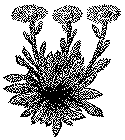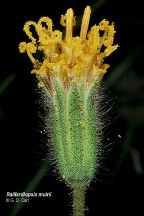Minerals
Muirite

Muirite is an orange-colored mineral, with a vitreous luster, in the silicate family. Muirite crystallizes in the tetragonal crystal system as
tetragonal crystal or as grains. It is found in metamorphic rock in
Fresno County, California.
The type locality is:
Big Creek / Rush Creek sanbornite deposit near Trimmer, Fresno County, Calif.
Its chemical composition is:
Ba10Ca2MnTiSi10O30(OH,Cl,F)10
Read more about Muirite.
|
Plants
Erigeron muirii
![[Erigeron muirii photo]](graphics/erigeron_muirii_small.jpg)
Muir's Fleabane, Erigeron muirii, is a daisy-like member of the aster family, named by famed Harvard botanist Asa Gray. Gray classified this species from a sample sent to him from Alaska by John Muir. Muir discovered the plant near Cape Thompson in northwestern Alaska.
(The family Asteraceae was formerly called the Compositae.)
Read more about Muir's Fleabane.

Sketch by John Muir
Ivesia muirii
Granite Mousetail

Photo
Copyright © 1987
Gary A. Monroe
CalPhotos - Berkeley Digital Library Project
View more photos and more information about Ivesia muirii. (Off-site link to CalPhotos. )
This member of the Rose family is found in the Sierra Nevada mountains of California.
John Muir sent the type specimen of this flower from Yosemite to Asa Gray
on February 22nd, 1873, writing, "Here are a few plants which I wish you would name for me." In reply, Gray wrote, "If you will keep botanizing in the High Sierra," he wrote, "you will find curious and new things, no doubt. One such, at least, is in your present collection in letter - the wee mouse-tail Ivesia ... Ivesia Muirii [sic] is the first fruit--'the day of small things.'
Read Muir's letter to Asa Gray.
Raillardiopsis muirii
Muir's Tarweed

Photo Copyright © by Gerald D. Carr. Used by permission.
According to Bruce G. Baldwin, Curator of the Jepson Herbarium, the genus name
Raillardiopsis has been abandoned and this species has been re-named Carlquistia muirii. See Review of Name Changes in California Tarweeds.
This member of the Asteraceae family is found in
Sequoia-Kings Canyon National Parks.
For more photos and species background, see Carlquisitia muirii page at University of Hawaii.
|
Animals
Trogolodytes troglodytes muiri

Winter Wren Photo by Deanna Dawson, USGS Patuxent Wildlife Research Center
Muir's Winter Wren is a sub-species of Winter Wren that ranges coastally from southwest Oregon through Marin County, California.
"The first bird named in honor of John Muir, whose life's work of conservation has helped protect the redwood habitat of this wren."
Read more about Muir's Winter Wren.
Ochotona princeps muirii
A pika sub-species found in Yosemite National Park, sometimes known as
the Yosemite cony. This sub-species was originally identified and named
by Joseph Grinnell and Tracy Storer in the early Twentieth Century. The
type locality is Ten Lakes, Yosemite National Park.
Thecla muirii
A butterfly found in the Sierra Nevada, one of several new species of
butterflies collected by Muir.
The species was named by actor-entomologist Henry Edwards,
who wrote,
"I have named this exquisite little species after my friend John Muir,
so well known for his researches into the geology of the Sierra Nevada,
who has frequently added rare and interesting species to my collection."
-
Papilio
, vol., 1, p. 54 (1881).
An extended excerpt of the Papilio description of how the species was collected by Muir and named after him, as well as a letter to Muir by Henry Edwards thanking Muir for the butterfly specimens is contained in Chapter 8 of The Life and Letters of John Muir, Volume 1.
Amplaria muiri
An arthropod, a milliped, one of several new species found in caves in
Sequoia and Kings Canyon National Parks, California.

Photo © by
Dr. Jean K. Krejca.
The new species was described by Dr. Shear and Dr. Krejca, who noted that
it was named:
"After John Muir, famous naturalist of the late nineteenth and early
twentieth century, whose name is forever connected with the Sierra Nevada,
which he called the 'Range of Light'."
Read more about Amplaria muiri. |